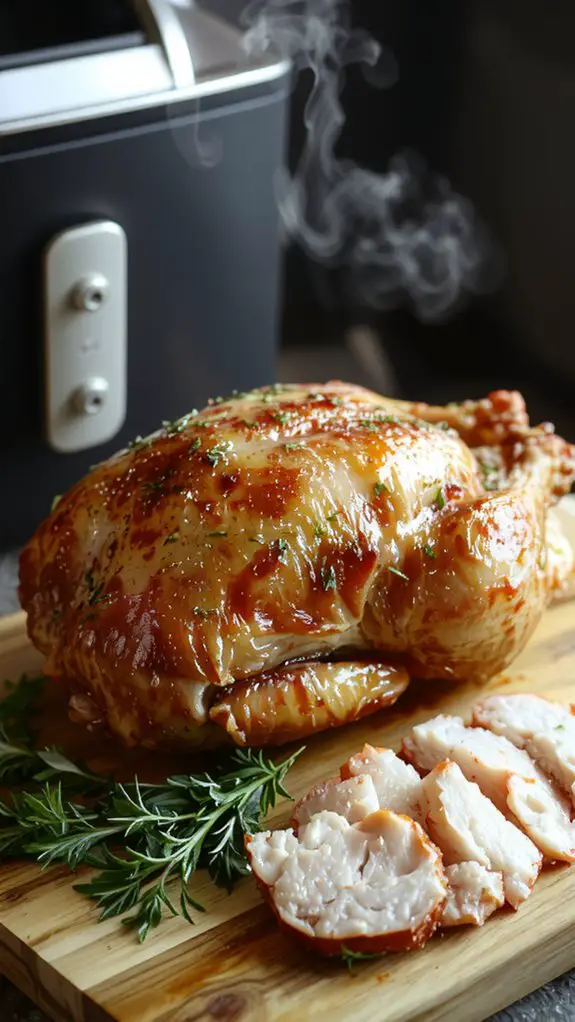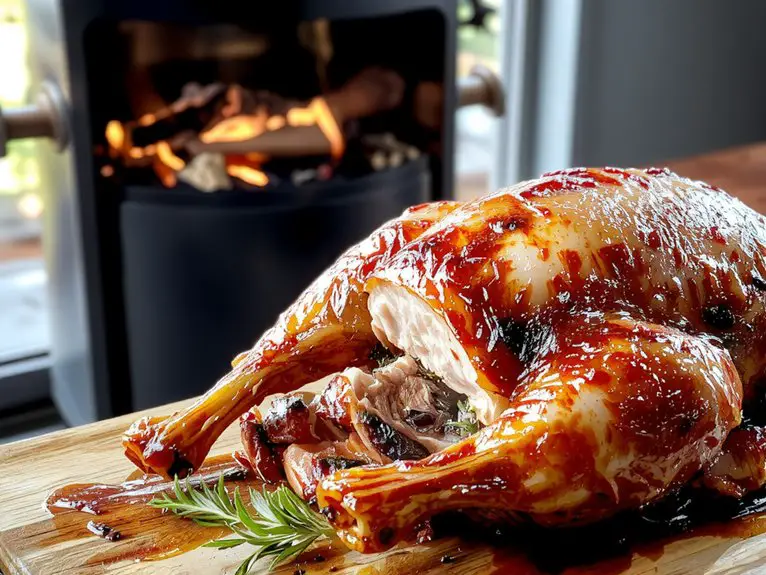I’ve perfected my smoked turkey recipe over the years, and it’s all about balancing flavor and technique. The secret lies in the brine, which infuses the meat with moisture and seasoning, and the low, slow smoking process that locks in a rich, smoky essence. It’s the kind of dish that turns heads at any gathering, but there’s a trick to getting the skin just right. Want to know how it’s done?
Recipe
There’s something magical about a perfectly smoked turkey—juicy, tender meat with that deep, smoky flavor that makes every bite unforgettable. This homemade smoked turkey recipe is hands-down the best way to elevate your holiday table or just treat yourself to something extraordinary.
The secret? A simple but powerful dry brine that locks in moisture, and a slow smoke that infuses every inch with rich, woodsy goodness. I’ve made this countless times, and it never fails to impress—whether it’s for Thanksgiving or a casual weekend feast.
Picture golden-brown skin giving way to succulent, smoky meat that practically melts in your mouth. Trust me, once you try this, you’ll never go back to plain roasted turkey again.
And the best part? It’s easier than you think to pull off. Let’s get smoking!
Ingredients
Smoking a turkey at home is all about achieving that perfect balance of smoky flavor and juicy meat. To get it right, you’ll need a mix of essentials and a few optional upgrades to make your bird unforgettable. Here’s what you’ll need:
- Whole turkey (12-14 lbs): Fresh or thawed—look for one with skin intact for crispy results. Pro tip: Air-dry the turkey in the fridge overnight for extra-crispy skin.
- Kosher salt: Essential for seasoning and brining. Swap with sea salt if necessary, but avoid table salt—it’s too fine and can over-season.
- Black pepper: Freshly ground is best for maximum flavor.
- Garlic powder: Adds depth to the seasoning—don’t skip it.
- Onion powder: Complements the garlic for a savory base.
- Paprika: Sweet or smoked paprika works wonders for color and a hint of smokiness.
- Brown sugar: Balances the saltiness and helps create a beautiful caramelized crust. Substitute with white sugar or honey if needed.
- Unsalted butter: Keeps the meat moist and adds richness. Use it under the skin for extra juiciness.
- Apple cider vinegar: Helps tenderize the meat. Substitute with white vinegar or lemon juice if necessary.
- Wood chips (hickory or applewood): Must-have for authentic smoky flavor. Soak them in water for at least 30 minutes before smoking. Pro tip: Mix wood types for a complex flavor profile.
- Fresh herbs (rosemary, thyme, sage): Optional but highly recommended for stuffing the turkey cavity. They infuse the meat with aromatic goodness.
- Chicken or turkey stock: For basting or injecting into the turkey for extra moisture.
Non-negotiable: Don’t skimp on the salt—it’s critical for flavor and moisture retention. Bonus tip: Add a splash of maple syrup to your basting liquid for a subtle sweetness that pairs perfectly with the smoke.
How to Make the Best Smoked Turkey Preparation Steps

– Prepare the turkey brine at least 24 hours before smoking: Dissolve salt, sugar, and any desired spices in water. Submerge the turkey completely in the brine and refrigerate. Brining guarantees the meat stays juicy during the smoking process.
*Pro Tip: Add herbs like rosemary or bay leaves to the brine for extra flavor.*
– Pat the turkey dry after brining: Remove the turkey from the brine and thoroughly pat it dry with paper towels. This step helps the skin crisp up during smoking.
*Watch-Out: Leaving the turkey wet can result in soggy skin.*
– Season generously with your dry rub****: Apply a mixture of paprika, garlic powder, onion powder, black pepper, and other spices all over the turkey, including under the skin. This creates a flavorful crust.
*Pro Tip: Let the seasoned turkey sit uncovered in the fridge for 1-2 hours to enhance the flavor.*
– Preheat your smoker to 225°F (107°C): Confirm the smoker is at the right temperature before adding the turkey. Low and slow smoking keeps the meat tender.
*Pro Tip: Use wood chips like hickory or applewood for a smoky, sweet flavor.*
– Place the turkey on the smoker: Position the turkey breast-side up on the smoker rack. Insert a meat thermometer into the thickest part of the thigh without touching the bone.
*Watch-Out: Avoid opening the smoker too often, as it can cause temperature fluctuations.*
– Smoke until the internal temperature reaches 165°F (74°C): This usually takes about 30 minutes per pound, but always rely on the thermometer for accuracy.
*Pro Tip: Baste the turkey with melted butter or apple cider every hour for added moisture and flavor.*
– Rest the turkey before carving: Once smoked, tent the turkey with aluminum foil and let it rest for at least 20 minutes. This allows the juices to redistribute.
*Watch-Out: Cutting too soon can cause the meat to dry out.*
– Carve and serve: Slice the turkey carefully, starting with the breast, and arrange it on a platter. Leftover smoked turkey makes great sandwiches or salads.
*Pro Tip: Use a sharp carving knife for clean, even slices.*
Nutrition
Understanding the nutritional content of this smoked turkey recipe can help you make informed dietary choices.
| Nutrient | Amount per Serving |
|---|---|
| Calories | 340 |
| Protein | 55g |
| Fat | 12g |
| Carbohydrates | 0g |
| Sodium | 480mg |
| Cholesterol | 160mg |
Chef Tips
Though smoking a turkey might seem intimidating, I’ve found that a few simple tricks can make the process smoother. Always brine overnight for juicier meat, and pat the skin dry before smoking for crispiness.
Use fruitwood like apple or cherry for mild flavor. Keep the smoker at 225°F—low and slow’s the key.
Spatchcocking cuts cooking time evenly. Let it rest 30 minutes before carving.






